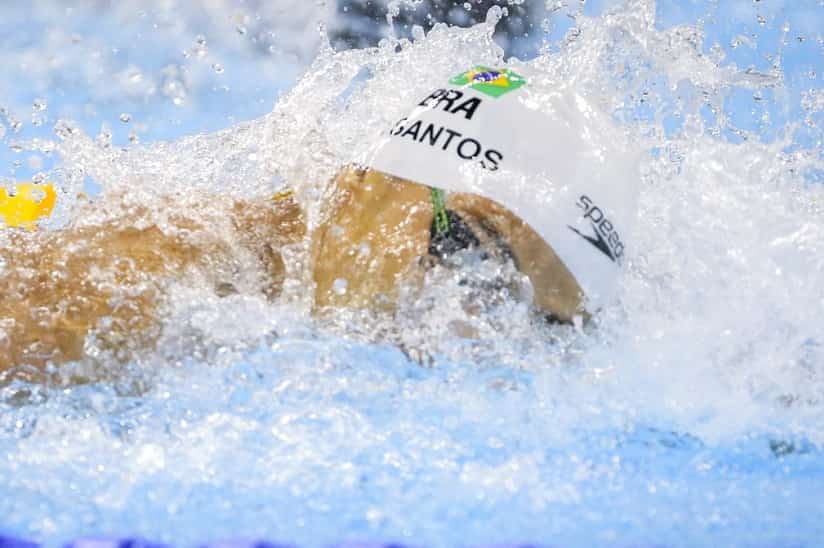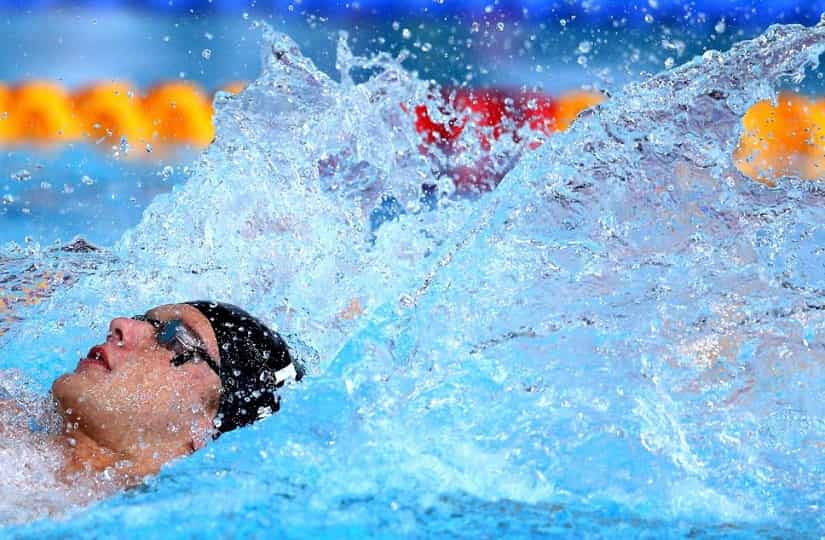Power. The very word conjures up an overwhelming sense of speed, of inevitability, of conquering the competition and the pool. Here is how to become a more powerful swimmer in the water.
When we watch the top swimmers in our sport we see an almost effortless technique.
But we also see a chlorinated ton of torque and power, from their kicking motion off the walls, the distance they explode off the blocks, the white torrent closing speed they finish their races with.
While they exude a measure of technical proficiency, make no mistake, the swimmers we seek to emulate have a massive deal of power in the water.
There are a ton of training aids out there that are designed to help you specifically with becoming a more powerful swimmer.
From hand paddles, to stretch chords, to drag suits, to swimmer’s fins, to VASA trainers to the swimmer’s parachute, and so on and so forth, there is no shortage of different forms of swimming equipment to play with that is designed to help you level up your brute strength in the pool.
Below I outlined three ways that you can achieve your goal of becoming a more powerful swimmer.
This little list is by no means comprehensive, and I limited it to the pieces of swimming gear that a swimmer can use completely on their own as well as within a team or group setting (not all solo swimmers are going to have access to a Power Tower, for instance).
Why Swimmers Should Train for Power in the Water
There are two main reasons that I like adding resistance in these specific ways:
First, the weak spots in your stroke will become apparent pretty quickly. What happens when we add load to our swimming is that it magnifies what we are doing in the water. Left hand not catching as much in the water? You’ll quickly notice the hiccup in the elasticity of the stretch cord. Not swimming with a balanced stroke? Same thing. Your breaststroke kick not contributing propulsion? You’ll notice in a hurry.
And secondly, you can maintain a proper range of motion and technique. There is such a thing as too much of a good thing, especially when technique starts to falter. In a recent article I wrote on the benefits of training with a drag suit researchers found that training with them for extended bouts of time changed technique and reduced distance per stroke, which is not what we are going for. We want perfect technique, first, and then to load it up to the point of failure.
3 Ways to Improve Your Power in the Water
Here are three different ways that you can incorporate resistance training in your next practice, and how to make the most of your time spent developing brute strength swimming power:
1. Swimming with a band.
For straight, sheer upper body strength this cannot be beaten.
While most swimmers lean on their pull buoy to build upper body endurance and strength, it does come with it’s share of drawbacks.
While it can help build general upper body endurance (without your legs sucking up precious oxygen you can also pull longer than you would be able to swim), it’s not great for power.
After all, you can only really get your tempo up so high. On the other hand, the band around your ankles forces you to come to grips with developing a stronger, more powerful pulling motion.
The moment you strap on a band around your ankles your stroke rate has to go up—otherwise you are gonna stink, err, sink, buckaroo.
Swimming with a band will also have your stroke become more balanced, your high elbow catch improves, and your stroke tempo increases.
All three things are absolutely essential for improving your freestyle stroke, especially you sprinters.
Training tips:
- If you’ve never used an ankle band before, start off using a pull buoy and graduate to dropping the pull buoy.
- Do short distances with lots of rest to start out with. If you aren’t doing it with proper technique stop and rest.
- If you are currently on the DL with a brutal case of swimmer’s shoulder, do not try swimming with just a band around your ankle until you heal up and/or fix the technical issues that led to the injury in the first place. Swimming with a band around your ankles is brutal on your shoulders.
2. Swimming or kicking with DragSox.
I kick. A lot. I often spend half of my workouts on my kickboard.
There are lots of reasons why I like doing heaps and heaps of kick sets, not the least of which is that I hate having my stroke fall apart towards the end of my races (as short as they may be), and to be honest, having a fast dolphin or freestyle kick is simply kind of awesome.
While I love using my swim fins to the point that I get gnarly blisters on my feet, I prefer using DragSox in order to build up the power in my legs.
They are my favorite for building crushing leg power. I have talked about why both in a post I did covering gifts for competitive swimmers, as well as in this essential swimming gear guide.
I’ll save you a click by reiterating why here again.
- They give you a full range of motion. Power comes from loading the movement you want to improve. With a proper pair of DragSox (they come with various degrees of difficulty) the range of motion and even the tempo should match up to your regular swimming. It’ll be harder, but that is the point!
- Improves feel for the water. The moment you take off the DragSox and perform a high intensity swim you will feel as though you were fired out of a cannon. I guess it’s something to do with an improved feel for the water, but it’s a feeling that you will want to experience for yourself.
- Endlessly versatile. I lean on my DragSox for vertical kick work, particularly when the local lap swim is too crowded. Or I will combo them with fins to really get the lactate churning in my legs. I will do sprint swim and sprint kick work with them on. Options are endless!
3. Resistance tubing.
In this case we aren’t talking about the type of stretch cords that you lasso around the flag pole, slip your hands into, bend over at the waist, and then wail away on. (Even though these do have their purpose.)
Nope, I am talking about the much funner kind—the type which you knot up one end to the starting block, and then buckle the other around your waist and swim out against it. More reliably known as a swim tether, stationary swim belt, or resistance swim belt.
Research that we detailed in another post talked about whether resistance training improved 50m sprinting performance. In that particular study, elite swimmers trained with resistance tubing twice a week, for 12-weeks.
The athletes swam against the chord, which was tied up to a starting block, and also getting speed-assist training by being pulled back by the tubing.
At the end of the 12-weeks, the swimmers improved speed over 50m versus the poor control group swimmers, who performed the regular workouts without the tube work.
There is one thing you will really notice when swimming against a stretch chord, and it’s something that is very hard to replicate otherwise…
The moment the chord goes taut and progress slows to a snail’s pace your body will naturally adjust into the most efficient position possible. As it turns out, your body is smart—it will seek the most efficient means to get through the water when faced with maximum resistance.
Training with the tubing for short bursts followed by high rest ends up serving a powerhouse double-whammy; you get high value power work in while ingraining efficient body position into your swimming.
Final Note: Contrast Your Power Work with Speed for Max Effect
The research mentioned earlier in the stretch chord section found that resistance training works best when you alternate it with speed boost sets.
In other words, don’t just pound out rep after rep of loaded sprinting—add some full swim sprinting, or swimming with fins, or with the resistance tubing—to get even more from your resistance training.
The speed-boost work will teach your body how to swim fastest with less effort more efficiently, which, when we think about it, is precisely the point of all of this!
More Stuff Like This:
40 Ultimate Swimming Workouts for Competitive Swimmers. Need some inspiration for your next workout? We got all you can handle and more with workouts from Michael Phelps, Katie Ledecky and much, much more.















